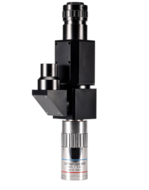Difference between microscope lens and telecentric lens
When choosing a lens for machine vision, understanding the difference between telecentric and microscope lenses is crucial.
Telecentric lenses minimize perspective distortion while offering consistent object size for precise measurements. They have moderate magnification (0.1x to 10x) and a larger working distance, allowing for more flexibility in setup.
In contrast, microscope lenses excel at high magnification (10x to 100x+) for detailed analysis of tiny features, but have fixed magnification and a very short working distance that requires the object to be extremely close to the lens, which can be limiting in some applications.
Magnification in microscope lens
Microscope lens can be a good choice for high magnification applications in machine vision, but there are some key things to consider regarding magnification:
- High Magnification: Microscope objectives typically offer much higher magnification than standard machine vision lenses, ranging from 10x to well over 100x. This allows you to see very tiny features of your object.
- Fixed Magnification: Unlike some machine vision lenses with zoom functionality, microscope objectives have a fixed magnification. You'll need to choose the right objective based on the specific size of features you need to inspect.
- Working Distance: Microscope objectives have a very short working distance, meaning the distance between the lens and the object is minimal. This can be a limitation in machine vision setups where there might need to be more space between the camera and the object.
How to select the right microscope lens
The nature of the application will determine which level of magnification is suitable. High-power objective lenses provide the most magnification possible and lower magnification lenses offer a wider field of view. If you are looking to easily add a light source, the version with coaxial input is recommended. You can
contact us to find the best solution for your application.
Microscope lens with or without coaxial input
Some microscope lenses have the ability for a coaxial light input. If the part number ends with -CO, the lens has a coaxial light input. If the part number ends with -NI, the lens has no coaxial light input. Compared to the version with coaxial light input, this microscope lens allows you to benefit of a more compact design.
By choosing the microscope lens with coaxial light input, you always have the option to choose the technical light configuration which offers more flexibility. The coaxial light input is ideal for illuminating flat shiny surfaces, such as metal and printed circuit boards.
As light source for the coaxial light input, we recommend our led spot
LED2-SPOT-12V-3W-White.
Applications for microscope lens
The microscope lenses are used in a variety of applications where high magnification and a short working distance are required. Examples of applications include sample analysis in laboratories and wafer inspection.
Microscopy software for image processing
Micro Manager (uManager) is image processing software for microscopy that is developed to control and automate microscopic applications. It is developed to serve as a complete image processing and microscope control package. This image processing software for microscopy is distributed with its source code, making it easy to extend for your specific microscopy or machine vision needs (e.g. your own camera drivers).
Quality control & Warranty of ours lenses
The lens production quality control process is built on several methodical steps. The process for lenses such as the microscope lens starts with a quality check of the incoming raw materials and the production line preparation. This preparation includes a check of workers PPE (Personal protective equipment) and the cleaning of equipment. During production, each step follows a strict process controlled by visual or tool aided inspections. Each product finishes production with a final inspection, confirming that optical and mechanical requirements are met. In addition, sample control inspections are performed before shipping.
This process generates comprehensive reports that covers all aspects of production. If at any time, the
microscope lens doesn’t comply with the given quality standards then it will be classified as abnormal. Action will be taken to guarantee the quality of the batch and the procedure. Consistent monitoring ensures that quality is maintained from the raw materials to the finished product.
